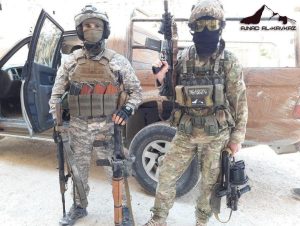
Baloch Rebels Strike Pakistani Army – An Inghimasi Style Attack !

Last evening, Baloch rebels attacked two military camps in Pakistan’s Balochistan province, one attack took place in Panjgur and the other in Noshki Frontier Corps camp. ISPR (Inter-Services Public Relations) had initially confirmed the death of only one soldier and four Baloch rebels, but it hid the fact that it was an Inghimasi style attack by Baloch rebels, an ISIS tactic used in the middle east. The Balochistan Information Minister later confirmed that so far 12 soldiers have been killed and 23 injured.
Recently ISIS-K (Khorasan) had announced that its first target is to destroy Pakistan. So, has Pakistani Army suffered heavy casualty on its side? Has ISIS dropped its roots deep into Pakistan? Is this why Pakistani Army is downplaying these attacks? Or have Baloch rebels really managed to overwhelm the Pakistani Army?
What is an Inghimasi Style Operation?
Like many other terrorist tactics used today, Inghimasi style attack too was inspired by Al Qaeda’s war against the Soviets in Afghanistan during the late 1980’s. This tactic was re-adopted by ISIS in 2016 to cause substantial damage to the professional armies it was countering at different locations in Syria and Iraq.

Heavily armed Inghimasi “commandos” from Syrian jihadist group Ajnad al-Kavkaz, via Reddit
The Inghimasi tactic has rendered itself to be one of the most effective tactics used by terrorist organizations in battles against enemies, especially attacks on command centers, front lines and fortifications during confrontations, while causing heavy causalities on the opposite side. This makes sense as to why the Baloch rebels relied on the tactic to enter the military camps in Panjgur and Noshki in Pakistan.
Inghimasi fighter may easily be misunderstood for a suicide bomber, but that’s not true. The former is akin to a special-forces style suicide fighter, who may or may not end his life during the mission.
While on a mission they have a gamut of objectives to achieve, such as inflicting a large number of casualties as far as possible from the entry point of a camp. If during the mission, they get trapped and have no route to escape, Inghimasi may use suicide vest to their final rescue. Au contraire, a suicide bomber’s mission is to detonate themselves in large gatherings to inflict as many casualties as possible. Ergo suicide bomber doesn’t have to be as physically fit as an Inghimasi fighter.
So these fighters are in good physical shape and are well trained before a mission. Their aim is to charge their enemies using small firearms, sporadically they use heavy weapons, whilst trying to penetrate enemy lines before ‘plunging’ into their enemies and detonating suicide vests.
To cause chaos and confusion, they fire mortars and rockets well behind the enemy lines, which surprisingly is very effective. According to a report published in Aoav.org.uk, in an Inghimasi attack in north of Mosul in May 2016, an American soldier was 2-3 miles behind the front line when he was killed by an IS fighter. This is a proof of how far behind enemy lines Inghimasi operation can reach, which is a remote possibility for a normal suicide bomber.
By now it is evident why Inghimasi fighters are considered to be of greater importance than suicide bombers in terrorist organizations.
In 2016, at least 100 soldiers were killed in an attack by Al Shabaab fighters who used Inghimasi tactics in AMISOM base, El Ado, Somalia.
Since Inghimasi attacks have usually caused heavy casualties, it is very possible that Pakistani Army is hiding the real numbers of soldiers it has lost in yesterday’s attack. BLA claims 95 soldiers were killed (45 in Noshki and 50 in Panjgur) while ISPR has so far confirmed death of only one soldier and that another soldier has suffered injuries.
The Baloch Operation

Balochistan Liberation Army’s social media account on different platforms have confirmed that a VBIED (Vehicle-Borne Improvised Explosive Device) was used to carry out the initial part of their operation at both Panjgur and Noshki camps. The Noshki city from where the first videos had emerged, appeared shaken by a powerful explosion. The windows of myriads of buildings, including the Civil Hospital adjacent to the Frontier Corps camp, were shattered. The blast was followed by heavy gunfire, after which the Pakistani Forces cordoned off the area, but by then Baloch rebels had managed to enter the camp. There was so much chaos and confusion that it lasted for 6 hours.
VBIED, vehicle borne IEDs, are either used as standard car bombing method, or are employed to break through the security barriers. In this case, clearly the Baloch rebels had managed to penetrate into the camp, and continued to hold their position long enough after the initial confusion caused by the VBIED blast.
Here’s a video which shows the initial damage in Noshki.
https://twitter.com/PhilanthropistI/status/1488896847884304388?s=20&t=rYBqBLjEpaCqDP7tc5oThA
In this video heavy gunfire and blasts can be heard. https://twitter.com/Natsecjeff/status/1488901030108672003?s=20&t=rYBqBLjEpaCqDP7tc5oThA
Later the Pakistani media and Army spokesperson confirmed that in Panjgur, rebels tried to enter the security forces’ camp from two different locations, and after their operation the rebels managed to flee. Clearly the suicide vests were not used. One soldier lost his life here. Meanwhile in Noshki, rebels attempted to enter the Frontier Corps (FC) camp which was ostensibly “promptly responded” to. Four rebels were killed in Noshki, and a soldier was injured in the intermittent shooting.
Baloch Rebels and ISIS
Three weeks ago, six ISIS terrorists were killed in Quetta, the capital city of Balochistan. A week before the attack Pakistani Army Major General Babar Iftikhar had told reporters that “Pakistan ISIS is not very active” and allayed any fears related to the terrorist organization.
As early as 2018, Pakistan Institute of Peace Studies (PIPS) had warned that ISIS has an organized presence in Pakistan, but the warnings fell on deaf ears. ISIS-K (Khorasan) has dropped its roots deep in eastern Afghanistan and some parts of Pakistan.
Baloch Liberation Army taking a leaf out ISIS tactics, using it successfully against Pakistani Army is a proof of the miserable plight the latter is in. Balochistan has in the last few weeks seen a spike in attacks against the Pakistani Army, with Baloch rebels having caused heavy casualty to the Army in different operations. A week ago, 10 Pakistani soldiers lost their lives in an attack, which was vehemently denied by ISPR initially, till proof emerged on social media and ISPR was forced to declare the real figures.
The latest attack has earned Pakistani Army Chief, General Bajwa many not-so-honorable sobriquets from the populace of Pakistan. Adding to his woes is the fact that with each passing day more and more corruptions within the organization are coming to the fore.
With Pakistan’s economy on crutches, Pakistani Army has no better option than to gulp the humiliation that it faces in Pakistan’s biggest province, Balochistan, which is 40% of Pakistan’s land mass. The real number of dead soldiers might never come to light from Noshki and Panjgur.
*****************
Disclaimer
The opinions expressed in this article are the author’s own and do not reflect the views of Chanakya Forum. All information provided in this article including timeliness, completeness, accuracy, suitability or validity of information referenced therein, is the sole responsibility of the author. www.chanakyaforum.com does not assume any responsibility for the same.
Chanakya Forum is now on . Click here to join our channel (@ChanakyaForum) and stay updated with the latest headlines and articles.
Important
We work round the clock to bring you the finest articles and updates from around the world. There is a team that works tirelessly to ensure that you have a seamless reading experience. But all this costs money. Please support us so that we keep doing what we do best. Happy Reading
Support Us





















POST COMMENTS (2)
China’s Latest Headache - Baloch Black Widow Strategy - Chanakya Forum
Kalidan Singh